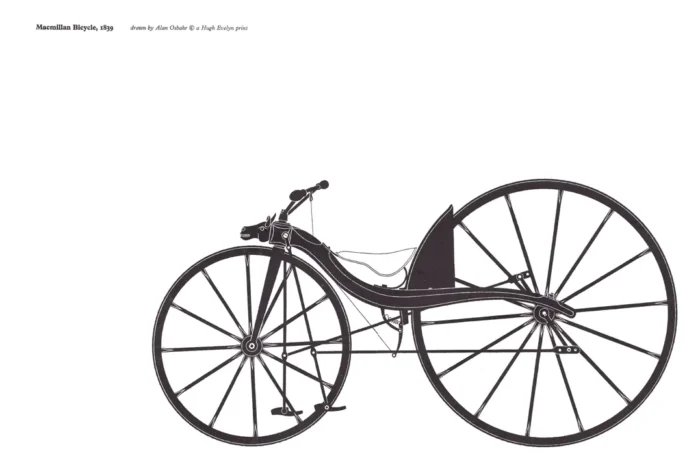1839 Macmillan Bicycle
£15.00
1839 Macmillan Bicycle (scroll down for a more detailed Description)
Published 1966 by © Hugh Evelyn Limited; drawn by Alan Osbahr
Size: c. 38 x 25 cm [15″ x 10″] may vary slightly from printers’ cut 50 years ago
Printed on white cardstock weighing 134 g/sm2
Print is STANDARD size – shipping is the same for 1 to 10 prints (based on largest print size in your order) – see Shipping & Returns
In stock
Description
This historic bicycle is a kind of ‘missing link’ between the earlier primitive hobby-horse and the kind of bicycle propelled by the rider’s feet operating pedals. Kirkpatrick Macmillan was a blacksmith working at Kier, Dumfriesshire and was the first person to discover and fully appreciate that a road machine with two wheels in line could be balanced and simultaneously propelled forward by the rider operating treadles and cranks connected to the rear wheel hub. The bicycle frame consists of a curved wooden bar, the front being carved to represent a horse’s head and the rear being forked to accommodate the rear driving wheel. Both wooden wheels have iron tyres; the front steering wheel is carried in an iron fork which passes through the forward end of the frame and has the handle-bar attached above. The saddle is mounted on a spring bolted to the frame. The brake is a wooden block applied to the rear wheel by a simple cord which can be tightened by rotating a part of the handle-bar: the world’s first method of twist-grip control – 1839. The hubs of both wheels run in plain bearings. The method of transmission on Macmillan’s bicycle is unique. The rear axle has cranks at both ends driven by separate connecting rods from intermediate points in two swinging levers which are pivoted near the steering head and carry wooden foot-treadles at their lower ends. The Macmillan bicycle has a front wheel 32 inches (81cm) in diameter and a rear wheel of 42½ inches (108 cm). The wheel base is 48 inches (123 cm) and the complete bicycle weighs 57 lb (26 Kg).
Additional information
| Weight | 0.0129 kg |
|---|---|
| Dimensions | 38 × 25.5 cm |

 1876 'Coventry' Tricycle
1876 'Coventry' Tricycle 


